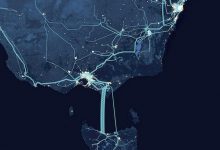Plans to build a second interconnector linking the wind and hydro-rich island state of Tasmania to the mainland Australian grid could unlock up to $5 billion in new renewables investments, but only if the rest of the NEM keeps up a fast pace of clean energy transition.
A final business case assessment of the proposed $3.5 billion Marinus Link – the key to Tasmania’s goal of being the “battery of the nation” – has found that a installing a second undersea cable across the Bass Strait was feasible at 1500MW capacity and could be in service from as early as 2027.
The newly published $20 million TasNetworks feasibility study – supported by $10 million from the federal government’s ARENA – found that establishing the new link along with supporting transmission would “provide greater benefits than costs under all modelled scenarios.”
On its own, the report said, the Marinus Link was expected to provide an economic boost to regional communities in Tasmania and Victoria in excess of $2.9 billion.
With supporting transmission, it would unlock wider added value up to an estimated $5.7 billion in Tasmania renewables developments, including new wind farms and pumped hydro energy storage enabled by the additional 1500 MW capacity across Bass Strait.
As you can see in the chart above, the benefits improve vastly depending on the pace of the transition to renewable energy – and away from coal-fired power – in other NEM states, and in particular, Victoria.
This, of course, means that any delay to the planned retirement of Victoria’s ageing coal-fired power plants would have a direct negative impact on the business case for the new link.
“If built, Marinus Link could support Australia’s transition to a low emissions future by expanding the renewable electricity generation and storage capacity in Tasmania, which could be exported across Bass Strait to support the National Electricity Market (NEM),” a statement from TasNetworks said on Thursday.
“At present, Tasmania can only export 500 MW as it is limited by the capacity of the existing interconnector Bass Link.”
The business case proposes the best way forward for the new interconnector would be to build it in two separate HVDC cables of 750MW each, on a route running from north west Tasmania near Burnie to the Latrobe Valley in Victoria.
TasNetworks also released the findings of the regulatory investment test (RIT-T) for transmission, which found that the optimal timing for Marinus Link and supporting transmission was for the first 750MW of capacity to come into service in 2028.
Following that, and depending on the scenario used, the timing of the second 750MW of capacity would be installed between 2030 and 2032.
The report acknowledged that while a 2027 target date did not presently optimise benefits under the RIT-T, this timing would still provide net benefits to the NEM over the project’s life under all scenarios modelled, as you can see in the chart above.
TasNetworks said the plan, now, was to begin the design and approvals phase for Project Marinus, for which the Australian government had committed another $56 million through ARENA.
“Tasmania has the potential to support the renewable energy transformation of the NEM that is currently taking place,” said ARENA CEO Darren Miller in comments on Thursday.
“With this business case showing that Marinus Link is feasible, we could see its vast pumped hydro and wind potential playing a key role in providing clean, low cost and dispatchable power to the NEM in the future.”










